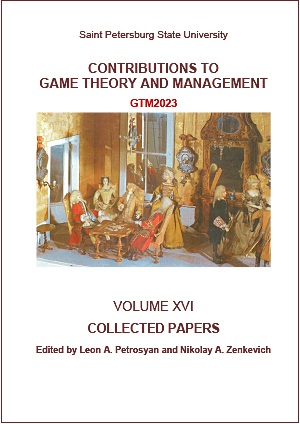Dynamic Cournot Oligopoly Models of the State Promotion of Innovative Electronic Courses in Universities
Abstract
We built and investigated a two-level dynamic game theoretic
model of control of the state promotion of innovative electronic courses in
universities based on Cournot oligopoly. A federal state is the Principal, and
universities competing a la Cournot are agents. The agents invest in the
development of new electronic educative courses that is considered as their
innovative investments. The Principal gives subsidies to the agents for the
promotion of innovations. The agents play a dynamic game in normal form
that results in a Nash equilibrium, and the Principal solves an inverse Stackelberg game (a Germeier game of the type Γ2t). We investigated different types of strategies: (1) uniform strategies for all agents; (2) type-dependent
(agent efficiency-dependent) strategies; (3) action-dependent strategies. For
a specific form of the model functions we found a solution in explicit form,
and in the general case we used a method of qualitatively representative
scenarios in simulation modeling. We analyzed the results by means of the
individual and collective relative efficiency indices.
Keywords:
Cournot oligopoly, inverse dynamic Stackelberg games, simulation modeling, university management
Downloads
References
Boltyanskii, V.G. (1978). Optimal Control of Discrete Time Systems.John Wiley and Sons, New York-Toronto, Ont.
Bonazzi, F. and Zilber, M. (2014). Innovation and business model: a case study about integration of innovation funnel and business model canvas. Review of Business Management, 53, 616–637.
Cellini, R. and Lambertini, L. (2002). A differential game approach to investment in product differentiation. J. of Economic Dynamics and Control, 27(1), 51–62.
Hakkarainen, K. (2014). The innovation funnel fallacy. International Journal of Innovation Science, 6(2), 63–72.
Kalachev, V. Yu., Ougolnitsky, G. A., Usov, A. B. (2022). A Difference Stackelberg Game Theoretic Model of Innovations Management in Universities. Contributions to Game Theory and Management, 15, 96–108.
Kalachev, V. Yu., Ougolnitsky, G. A., Usov, A. B. (2023). Difference Stackelberg game theoretic model of innovations in universities as Cournot oligopoly. Frontiers of Dynamic Games. Trends in Mathematics. Birkhäuser, Cham. (to appear).
Makarov, V. L. (2009). A review of the mathematical models of economics with innovations. Economics and Mathematical Methods, 45(1), 3–14.
Malsagov, M. Kh., Ougolnitsky, G. A., Usov, A. B. (2020). A Differential Stackelberg Game Theoretic Model of the Promotion of Innovations in Universities. Advances in Systems Science and Applications, 20(3), 166–177.
Ougolnitsky, G. A. and Usov, A. B. (2016). Solution algorithms for differential models of hierarchical control systems. Automation and Remote Control, 77(5), 872–880.
Ougolnitsky, G. A. and Usov, A. B. (2018). Computer Simulations as a Solution Method for Differential Games. Computer Simulations: Advances in Research and Applications. Eds. M.D. Pfeffer and E. Bachmaier., N.Y.: Nova Science Publishers, 63–106.
Ougolnitsky, G. A. (2022). An Approach to Compare Organization Modes of Active Agents and Control Methods. Control Sciences, 3, 24–33.
Ugolnitskii, G. A. and Usov, A. B. (2014). Equilibria in models of hierarchically organized dynamic systems with regard to sustainable development conditions. Automation and Remote Control, 75(6), 1055–1068.
Downloads
Published
How to Cite
Issue
Section
License
Articles of "Contributions to Game Theory and Management" are open access distributed under the terms of the License Agreement with Saint Petersburg State University, which permits to the authors unrestricted distribution and self-archiving free of charge.




